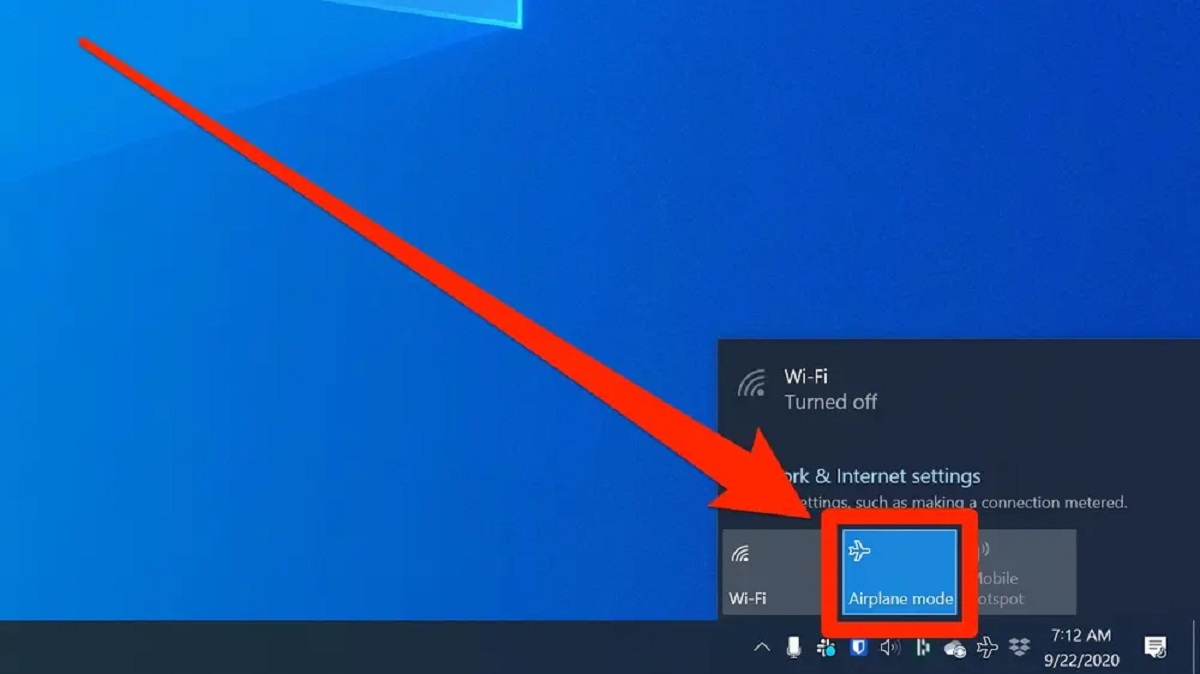Introduction
Welcome to the digital age, where the threat of cyber attacks and malware is ever-present. Protecting your laptop from these potential dangers is crucial, and one of the most effective ways to do so is by installing reliable antivirus software. Whether you’re a tech-savvy individual or a beginner, this guide will walk you through the process of downloading antivirus software for your laptop.
Antivirus software is designed to detect, prevent, and remove malicious software, such as viruses, worms, trojans, and spyware, that can harm your laptop and compromise your personal information. It acts as a shield, constantly monitoring your system, scanning files, and blocking any suspicious activity.
Before diving into the steps, it’s essential to understand that there are various types of antivirus software available, ranging from free to premium versions. The free versions offer basic protection, while the paid ones come with additional features and advanced security options.
Now, let’s explore the step-by-step process of downloading antivirus software for your laptop and ensuring optimal protection against cyber threats.
Step 1: Determine the type of antivirus you need
Before embarking on the download process, it is crucial to determine the type of antivirus software that best suits your needs. This will depend on factors such as your budget, desired level of protection, and specific features you require.
There are generally two types of antivirus software available: free and paid versions.
Free antivirus software: This type of software provides a basic level of protection for your laptop at no cost. While they may not offer the full range of features found in paid versions, free antivirus software can still provide essential protection against common threats.
Paid antivirus software: If you’re looking for more advanced features and enhanced protection, opting for a paid version may be the best choice. These software packages often include additional security measures such as real-time scanning, firewall protection, and email spam filtering. Paid antivirus software is typically more comprehensive and offers a higher level of security for your laptop.
Consider factors such as your browsing habits, the sensitivity of the data stored on your laptop, and the value you place on comprehensive protection. By evaluating your specific needs, you can make an informed decision on the type of antivirus software that best suits you.
Additionally, do some research and read reviews about different antivirus software options. Look for software that has a good track record of protecting against the latest threats and is regularly updated to stay ahead of emerging risks.
Once you have determined whether you prefer a free or paid antivirus software, you can move on to the next step: choosing a trusted antivirus software provider.
Step 2: Choose a trusted antivirus software
Now that you’ve decided on the type of antivirus software that suits your needs, it’s time to choose a trusted and reputable provider. With so many options available, it’s essential to do your research and select a software provider that has a solid reputation in the industry.
Here are a few factors to consider when choosing a trusted antivirus software:
- Reliability: Look for software that consistently receives positive reviews and recommendations from users and industry experts. A reliable antivirus software provider will have a track record of effectively detecting and eliminating malware.
- Features: Determine which features are important to you. Do you need real-time scanning, firewall protection, or parental controls? Evaluate the features offered by different antivirus software providers and choose the one that aligns with your specific requirements.
- Ease of use: Consider the user-friendliness of the software. Look for an intuitive interface that makes it easy to navigate and configure your antivirus settings. The software should provide clear instructions and prompts throughout the installation and scanning processes.
- Customer support: Check whether the antivirus software provider offers reliable and accessible customer support. It’s essential to have assistance available in case you encounter any issues or have questions about the software.
- Compatibility: Ensure that the antivirus software is compatible with your laptop’s operating system. Most software will support popular operating systems like Windows, Mac OS, and Linux, but it’s always best to double-check the system requirements before making a decision.
Take your time to compare different antivirus software providers and their offerings. Read reviews, visit their official websites, and evaluate the pros and cons of each option. By selecting a trusted and reputable antivirus software provider, you can have peace of mind knowing that your laptop is well-protected against malware and cyber threats.
Step 3: Access the official antivirus website
Once you have chosen a trusted antivirus software provider, the next step is to access their official website. It is important to download antivirus software directly from the official source to ensure its authenticity and avoid any potential security risks.
To access the official antivirus website, follow these steps:
- Open your web browser and type in the URL of the antivirus software provider. If you are unsure of the exact URL, you can use a search engine to look up the provider’s name, and their official website should be among the top search results.
- When accessing the website, make sure to double-check the URL to ensure that you are on the official site. Cybercriminals may create fake websites that mimic the appearance of legitimate antivirus software providers, so it’s crucial to verify the website’s authenticity.
- Look for the padlock symbol in the browser address bar, which indicates that the website has a secure SSL (Secure Sockets Layer) connection. This signifies that any data you enter on the website will be encrypted and protected.
- Verify that the website has a professional look and feel, with clear and well-organized information. Legitimate antivirus software providers invest in creating a professional and user-friendly website to showcase their product.
By accessing the official website, you can be confident that you are downloading the genuine antivirus software and minimizing the risk of compromising your laptop’s security.
Step 4: Find the download section
After accessing the official website of the antivirus software provider, the next step is to locate the download section. This is where you’ll find the appropriate files to download and install the antivirus software onto your laptop.
To find the download section, follow these steps:
- Take a look at the website’s navigation menu or header. Often, you’ll find a prominent option labeled “Downloads,” “Get Antivirus,” or something similar. Click on this option to proceed to the download section.
- If there isn’t a specific download option on the navigation menu, scroll through the web page and look for links or buttons that lead to the download section. Common labels include “Download Now,” “Get Started,” or “Try for Free.” Click on the appropriate link to proceed.
- Some antivirus software providers may have different product versions or packages available, such as a free version and premium versions with advanced features. In this case, you may need to choose the version you prefer or click on the relevant option to access the download section for that specific version.
- Once you have entered the download section, you may be presented with additional information about the software, including its features, system requirements, and subscription options. Take the time to review this information and ensure that the software is compatible with your laptop’s operating system.
By locating the download section on the antivirus software’s official website, you can take the next step towards securing your laptop with the chosen antivirus solution.
Step 5: Select the appropriate version for your laptop’s operating system
Now that you have found the download section on the official website of the antivirus software provider, it’s time to select the appropriate version for your laptop’s operating system. This step ensures that you download the correct software that is compatible with your specific device.
Follow these steps to select the appropriate version:
- Check the download options available on the website. Antivirus software providers usually offer different versions for various operating systems, such as Windows, Mac OS, or Linux. Look for the version that corresponds to your laptop’s operating system.
- If you’re unsure about your laptop’s operating system, you can check it by going to your laptop’s settings. On Windows, click on the Start button, then navigate to the Settings menu. Look for the “System” option and click on it. Under the “About” or “System Information” section, you should find information about your operating system version. On a Mac, click on the Apple icon in the top left corner of your screen, then select “About This Mac” to find information about your operating system version.
- Once you have determined the correct version for your operating system, click on the respective download button or link. This will initiate the download process for the specific version of the antivirus software.
- Be cautious while selecting the version and ensure that you’re not inadvertently downloading the wrong version. Using antivirus software that is not compatible with your operating system may lead to installation issues or functionality problems.
By selecting the appropriate version that matches your laptop’s operating system, you can ensure a smooth installation process and optimal performance of the antivirus software.
Step 6: Read the download instructions and system requirements
Before proceeding with the download process, it is crucial to carefully read the download instructions and system requirements provided by the antivirus software provider. These instructions will guide you through the installation process and ensure that your laptop meets the necessary specifications for the antivirus software to function properly.
To read the download instructions and system requirements, follow these steps:
- Once you have selected the appropriate version for your laptop’s operating system and clicked on the download button or link, you will likely be redirected to a new page or prompted to download the setup file.
- Before initiating the download, spend some time reviewing the information provided on this page. Look for any specific instructions or recommendations regarding the installation process. Some antivirus software providers may have additional steps or considerations that you need to be aware of.
- Pay close attention to the system requirements listed on this page. This includes information about the minimum hardware specifications and supported operating systems. Ensure that your laptop meets these requirements to avoid any compatibility issues or performance limitations.
- If you have any doubts or questions about the download instructions or system requirements, seek clarification by contacting the antivirus software provider’s customer support. They can provide you with the necessary assistance and address any concerns you may have.
Reading and understanding the download instructions as well as the system requirements is crucial to ensure a successful installation and optimal performance of the antivirus software on your laptop. By following these guidelines, you can proceed with confidence to the next step of the download process.
Step 7: Start the download process
Now that you have thoroughly reviewed the download instructions and system requirements, you’re ready to start the download process of the antivirus software onto your laptop. This step will initiate the transfer of the necessary files from the antivirus software provider’s website to your computer.
To start the download process, follow these steps:
- On the download page or prompt, you will typically find a button or link labeled “Download” or “Download Now.” Click on this button to begin the download.
- Depending on your web browser and its settings, you may be asked to save the setup file or specify a download location on your computer. Choose a location that is easily accessible, such as your desktop, to make it easier to locate the setup file later.
- During the download process, it’s important to be patient, especially if the antivirus software package is large in size. The download speed will depend on your internet connection, so it may take a few minutes or longer to complete.
- While the download is in progress, avoid navigating away from the download page or closing the browser window. Doing so may interrupt the download and require you to start the process again.
- Once the download is complete, you will have the setup file ready to install the antivirus software onto your laptop. At this stage, it’s a good idea to verify the integrity of the downloaded file by comparing its checksum or using antivirus software to scan it for any potential threats. This ensures that you have a safe and legitimate setup file.
By following these steps, you can successfully start the download process and obtain the necessary files for installing the antivirus software onto your laptop. Now, you’re one step closer to securing your laptop against potential threats.
Step 8: Wait for the download to complete
After starting the download process of the antivirus software, it’s important to exercise patience and wait for the download to complete. The duration of the download will depend on various factors, including the size of the antivirus software package and the speed of your internet connection.
Here are a few things to keep in mind while waiting for the download to complete:
- Be patient: Depending on the size of the antivirus software package and your internet connection, the download process may take some time. Avoid interrupting the download or closing the browser window, as this can lead to an incomplete download or the need to start the process over.
- Monitor the progress: Some web browsers display a download progress bar or provide indications of the remaining download time. You can keep an eye on these indicators to get an estimate of how much longer the download will take.
- Consider your internet connection: If you have a slow or unreliable internet connection, it may take longer to complete the download. You can try connecting to a more stable network or consider downloading the software during non-peak hours when internet speeds tend to be faster.
- Make use of the waiting time: While waiting for the download to complete, you can utilize the time by preparing for the installation process. Ensure that your laptop is connected to a power source to avoid any interruptions during the installation. You can also close any unnecessary applications or files to free up system resources for the upcoming installation.
- Ensure the download is secure: As the download progresses, keep an eye out for any red flags or warnings from your antivirus software or browser. These may indicate potential security risks. If you encounter any warnings, it may be advisable to abort the download and investigate further before proceeding.
By patiently waiting for the download to complete and taking the necessary precautions, you can ensure that you have successfully obtained the required files for installing the antivirus software onto your laptop.
Step 9: Install the antivirus software
Once the download is complete and you have the setup file for the antivirus software, you are ready to proceed with the installation process. Installing the antivirus software will integrate it into your laptop’s system, enabling it to actively protect your device against various threats.
Follow these steps to install the antivirus software:
- Locate the downloaded setup file on your computer. This is typically saved in the location you specified during the download process. If you’re unable to find the file, you can use the search function on your computer to locate it.
- Double-click on the setup file to start the installation process. Some antivirus software may require administrator privileges to install, so if prompted, confirm that you want to allow the software to make changes to your device.
- The installation process may vary depending on the antivirus software you are installing. Follow the on-screen prompts, paying attention to any additional options or settings you may need to configure. These may include language preference, installation location, and other customization options.
- Read and agree to the terms and conditions, if prompted. It is important to review the terms of use and privacy policy of the antivirus software before proceeding with the installation.
- Once you have selected the desired options and agreed to the terms, click on the “Install” or similar button to begin the installation process.
- The installation process may take a few minutes. During this time, the antivirus software will integrate into your laptop’s system, and necessary files will be copied to their respective locations.
- Once the installation is complete, you may be prompted to restart your computer. It is recommended to restart your laptop to ensure that the antivirus software is fully integrated into your system and starts working effectively.
By following these steps, you can successfully install the antivirus software onto your laptop. Once the installation is complete, you can proceed to the next step of activating and configuring the antivirus software to ensure optimal protection against threats.
Step 10: Follow the installation wizard’s prompts
During the installation process of the antivirus software, you will generally encounter an installation wizard that guides you through the necessary steps. It is important to carefully follow the prompts presented by the installation wizard, as they ensure a smooth and successful installation of the software onto your laptop.
Here’s what you need to do to follow the installation wizard’s prompts:
- After initiating the installation process by running the setup file, the installation wizard will open. This wizard provides step-by-step instructions and options to configure the antivirus software on your laptop.
- Read each prompt carefully, as it may present you with important choices and customization options. Depending on the antivirus software, you may be able to choose specific components or features to install, such as a firewall, web protection, or automatic scanning options. Review the available options and select the ones that align with your preferences and needs.
- If prompted, select the installation language that you are most comfortable with. Many antivirus software providers offer multiple language options to cater to a global user base.
- Review the license agreement and terms of use. It is essential to understand and accept the terms before proceeding with the installation. Take the time to read through the agreement, or at least skim through the important sections.
- Choose the destination folder where you want the antivirus software to be installed. The installation wizard will typically present a default location, but you can browse and select a different folder if desired. Make sure to choose a location with sufficient storage space.
- Proceed through the installation wizard, following the remaining prompts and options provided. Most prompts are straightforward and require you to click on “Next,” “Install,” or similar buttons to continue. Take your time and ensure that you have selected the desired options before proceeding.
- Once the installation wizard completes the installation process, you will likely see a confirmation message indicating that the antivirus software has been successfully installed onto your laptop.
By attentively following the prompts of the installation wizard, you can ensure that the antivirus software is installed correctly and configured to your preferences. This step brings you closer to activating the software and safeguarding your laptop against potential threats.
Step 11: Activate your antivirus
After successfully installing the antivirus software, the next crucial step is to activate it. Activation is necessary to validate your license, gain access to the full features of the software, and ensure that your laptop receives the latest updates and protection against evolving threats.
Follow these steps to activate your antivirus software:
- Open the antivirus software program on your laptop. You can typically find it by searching for the software’s name in the Start menu or by locating its shortcut on your desktop or taskbar.
- Look for an option labeled “Activate,” “License,” or “Settings” within the antivirus program’s interface. The exact location of this option may vary depending on the software you are using.
- Click on the appropriate option to open the activation menu. You may be asked to enter your license key or activation code. This code is generally provided to you upon purchase or included in the confirmation email from the software provider.
- Enter your license key or activation code into the designated field. Take care to accurately input each character to ensure successful activation. Some antivirus software may automatically detect and validate the license key if you have purchased it directly from their website.
- If the license key is valid, the antivirus software will proceed to activate your account and verify the license. It may take a few moments for the activation process to complete.
- Once your antivirus software is successfully activated, you may be prompted to restart your laptop. This step ensures that all necessary components of the software are fully integrated into your system.
- After restarting, you can verify the activation by checking the software’s status or license information within its settings or preferences menu.
By following these steps, you can activate your antivirus software and ensure that your laptop is protected with the full capabilities of the software. Regularly check for updates to keep your antivirus software up to date, as new threats emerge frequently and software updates often include important security patches and enhancements.
Step 12: Update your antivirus software
Once your antivirus software is activated, it’s important to regularly update it to ensure that your laptop is protected against the latest threats. Antivirus software providers release updates that include new virus definitions, security patches, and enhancements to keep your device secure.
Follow these steps to keep your antivirus software up to date:
- Open your antivirus software program on your laptop. Look for an option labeled “Update,” “Check for Updates,” or a similar function within the software’s interface. The location of this option may vary depending on the software you are using.
- Click on the appropriate option to initiate the update process. The antivirus software will connect to the software provider’s server to check for available updates.
- If updates are available, follow the prompts and instructions to download and install the updates. This process may vary depending on the antivirus software you are using. Some software may automatically download and install updates, while others may require manual intervention.
- Ensure that your laptop is connected to the internet during the update process. Depending on the size and number of updates, the process may take a few minutes to complete. Be patient and avoid interrupting the update.
- Once the updates have been successfully installed, your antivirus software will be equipped with the latest virus definitions and security enhancements. This ensures that your laptop remains protected against the most current threats.
- Set your antivirus software to automatically check for updates on a regular basis. Most antivirus software programs offer the option to configure automatic updates to ensure that your system stays protected without requiring manual intervention. This way, you can have peace of mind knowing that your antivirus software is always up to date.
By regularly updating your antivirus software, you enhance its effectiveness in safeguarding your laptop. Keeping your software up to date is crucial as cyber threats continually evolve, and software updates often address vulnerabilities and enhance protection against these evolving threats.
Conclusion
Securing your laptop with antivirus software is essential in today’s digital landscape where cyber threats are prevalent. By following the step-by-step guide outlined above, you can successfully download and install antivirus software onto your laptop, providing a crucial layer of protection against malware, viruses, and other malicious threats.
Starting with determining the type of antivirus you need and selecting a trusted software provider, you can make informed decisions that align with your specific requirements. Accessing the official antivirus website and locating the download section ensures that you obtain the software directly from the legitimate source.
Reading the download instructions and system requirements is crucial to ensure compatibility with your laptop’s operating system and understand any specific instructions or recommendations provided by the software provider.
Once you have downloaded the antivirus software, following the installation wizard’s prompts enables a smooth and successful installation process. Activating the software with your license key ensures that you have access to the full features and ongoing updates to keep your laptop protected.
Lastly, regularly updating your antivirus software helps you stay protected against the latest threats by incorporating new virus definitions and security enhancements.
By following these steps, you can confidently install, activate, and maintain an effective antivirus solution on your laptop, providing a robust defense against potential cyber threats. Remember to perform regular scans, practice safe browsing habits, and stay educated about emerging threats to further enhance your online security.

























